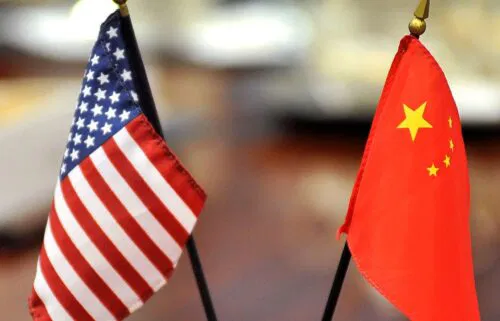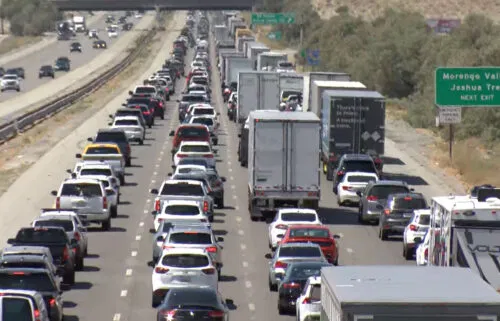Migrants face new border reality as Title 42 pandemic restrictions expire
By VALERIE GONZALEZ, ELLIOT SPAGAT and GIOVANNA DELL’ORTO
Associated Press
EL PASO, Texas (AP) — The U.S. entered a new immigration enforcement era Friday, ending a three-year-old asylum restriction and enacting a set of strict new rules that the Biden administration hopes will stabilize the U.S.-Mexico border and push migrants to apply for protections where they are, skipping the dangerous journey north.
The transition has been far from simple. Even as the old policy known as Title 42 expired, migrants along the border were still wading into the Rio Grande to take their chances getting into the country, defying officials shouting for them to turn back. Others hunched over cellphones trying to access an appointment app, a centerpiece of the new measures, while others with appointments walked across a bridge hoping for a new life. And lawsuits sought to stop some of the measures.
The Biden administration has said the new policies are meant both to crack down on illegal crossings and to offer a new legal pathway for migrants who spend thousands on smuggling operations to get them to the U.S.-Mexico border. Migrants are now essentially barred from seeking asylum in the U.S. if they first didn’t seek protection in the countries they traveled through or applied on line. Families allowed in as their immigration cases progress will face curfews and GPS monitoring. Meanwhile, new migration hubs will be stationed in Colombia and Guatemala, with plans to open 100 more in the Western Hemisphere.
If it works, it could fundamentally alter how migrants come to the southern border. But President Joe Biden, who is running for reelection, is facing withering criticism from migrant advocates who say he’s abandoning more humanitarian methods and Republicans who claim he’s soft on border security.
On Friday morning, small groups of Haitian migrants with appointments to request asylum crossed the Gateway International Bridge connecting Matamoros, Mexico with Brownsville, Texas. They crossed with the assistance of a nongovernmental organization, passing the usual commuter traffic of students and workers lined up on the pedestrian path of the bridge. Car traffic appeared normal.
That is the scenario U.S. officials are hoping for. But many migrants and the advocates who help them say those who have fled their home countries for a myriad of reasons are at such a risk they cannot wait.
Migrant families — with some parents holding children — hesitated only briefly as the deadline passed before entering the waters of the Rio Grande near Brownsville, clutching cellphones above the water to light the way as U.S. officials shouted to turn back.
“Be careful with the children,” an official shouted through a megaphone. “It is especially dangerous for the children.”
Separately, at an outdoor encampment of migrants beside a border bridge in Ciudad Juárez, across from El Paso, Texas, cellphones were alight as migrants attempted to book an asylum appointment online through an app administered by U.S. Customs and Border Protection.
“There’s no other way to get in,” said Venezuelan Carolina Ortiz, accompanied by her husband and children, ages 1 and 4. Others in the camp had the same plan: keep trying the app.
The expired rule, known as Title 42, has been in place since March 2020. It allowed border officials to quickly return asylum seekers back over the border on grounds of preventing the spread of COVID-19. The U.S. has declared the national emergency over, and with it, the restrictions end.
While Title 42 prevented many from seeking asylum, it carried no legal consequences, encouraging repeat attempts. After Thursday, migrants face being barred from entering the U.S. for five years and possible criminal prosecution.
During the transition, at the U.S. border with Tijuana there was no visible reaction amid among hundreds of migrants who were in U.S. custody between two border walls, many of them for days with little food. They slept on the ground under bright lights in cool spring air. Shelters across Tijuana were filled with an estimated 6,000 migrants.
It was not clear how many migrants were on the move. By Thursday evening before the expiration, the flow seemed to be slowing in some locations, but it was not clear why, or whether crossings would increase again.
Border Patrol chief Raul Ortiz said in a Tweet Friday morning that the agency had apprehended 67,759 people in the last week. That averages out to 9,679 per day — nearly twice the average daily level of 5,200 from March. It’s slightly below the 11,000 figure that authorities have said is the upper limit of what they expect after Title 42 ends, but it wasn’t clear how much the numbers peaked in the days and hours Title 42 expired Thursday night.
Homeland Security Secretary Alejandro Mayorkas warned of overcrowding.
“We’re seeing precisely the challenge we expected,” Mayorkas said Friday on ABC’s Good Morning America. “We cannot control the movement of people before they reach our border.”
More than 27,000 people were in U.S. Customs and Border Protection custody. Holding facilities along the border already were far beyond capacity. Officials had orders to release people with a notice to report to an immigration office in 60 days if facilities reached 125% capacity or when they were held 60 hours or more. The quick releases were to also be triggered when authorities stop 7,000 migrants along the border in a day.
But late Thursday, a federal judge appointed by Trump temporarily halted the administration’s plans to release people into the U.S., and set a court date on whether to extend it more.
In a statement, Customs and Border Protection said it would comply with the court order, while calling it a “harmful ruling that will result in unsafe overcrowding.”
And advocacy groups sued the administration on its new asylum rules minutes before they took effect.
The lawsuit, filed in federal court in San Francisco by the Center for Gender & Refugee Studies and other groups, alleges the Biden administration “doubled down” on a policy proposed by Trump that the same court rejected. The Biden administration argues its rule is different because it’s not an outright ban but a higher burden of proof to get asylum and it pairs restrictions with other newly opened legal pathways.
Meanwhile, immigration officials were beefing up deportation flights of migrants found unqualified to stay in the U.S. Nearly 400 migrants were returned home to Guatemala from the U.S. on Thursday.
Among them was Sheidi Mazariegos, 26, who arrived with her 4-year-old son just eight days after being detained near Brownsville by Border Patrol.
“I heard on the news that there was an opportunity to enter, I heard it on the radio, but it was all a lie,” she said.
At the same time, up to 30,000 people a month from Haiti, Cuba, Nicaragua and Venezuela can enter if they apply online with a financial sponsor and enter through an airport. Processing centers are opening in Guatemala, Colombia and elsewhere. Up to 1,000 can enter daily though land crossings with Mexico if they snag an appointment on an online app.
At shelters in northern Mexico, many migrants chose not to rush to the border and waited for existing asylum appointments or hopes of reserving one online.
At the Ágape Misión Mundial shelter in Tijuana, hundreds of migrants bided their time. Daisy Bucia, 37, and her 15-year-old daughter arrived at the shelter over three months ago from Mexico’s Michoacán state fleeing death threats, and have an asylum appointment Saturday in California.
Bucia read on social media that pandemic-era restrictions were ending at the U.S.-Mexico border, but wasn’t sure if it was true and preferred to cross with certainty later.
“What people want more than anything is to confuse you,” Bucia said.
___
Gonzalez reported from Brownsville, Texas; Spagat reported from Tijuana, Mexico. Associated Press writers Colleen Long and Rebecca Santana in Washington; Christopher Sherman in Mexico City; Gerardo Carrillo in Matamoros, Mexico; Maria Verza in Ciudad Juarez, Mexico; Morgan Lee in Santa Fe, New Mexico; and Suman Naishadham in Tijuana, Mexico contributed to this report.



